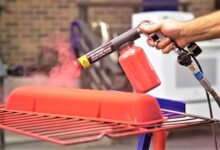Introduction to Powder Coating
Powder coating is a dry finishing technique in which thermoplastic or thermoset powder substance rather than a liquid solution is sprayed onto a surface, melted, and then allowed to dry and harden into a protective coating. The powder is commonly applied using ESD to an electrically grounded metal baseboard.
Powder coats are applied by spraying a powder material over preheated parts and then baking them until the powder melts and runs together. Parts may also be dipped into powder material in a fluidized bed to apply powder coatings. When the part comes into contact with the heated surface, the melted powder fuses with it. The cured powder gives an appealingly smooth, durable finish once the part has dried and cooled.
Powder coating services may be used on a variety of materials, including metals, plastics, glass, and medium-density fiberboard (MDF), and can create both functional and aesthetic surface coatings in a variety of colours, styles, finishes, and textures that aren’t readily attainable by liquid coating techniques. Powder coatings are also more long-lasting, cost-effective, and environmentally friendly than standard liquid coatings. They may not be appropriate for all manufacturing processes due to their low budget requirement, thin-film necessity, or big component coverage need.
This article is about powder coating, which is the topic of this post. It goes through the benefits and disadvantages of powder coating, as well as comparisons between the powder and liquid coating technologies.
Advantages and Benefits of Powder Coating
Powder coating has several advantages and benefits over other liquid coating processes. These include:
- The coating that is more long-lasting
- Provides for heavier and specialized coatings
- Reduced carbon footprint
- Wood has become more successfully treated and dried.
- Increased material output
Durability
Powder coating is a type of paint that provides a hard, protective, and attractive finish. Powder coatings resist impact, moisture, chemicals, and extreme weather better than most liquid coatings of comparable thickness and provide a part or product greater protection from scratches, chipping, abrasions, corrosion, fading, and general wear.
They can also serve as electrical insulators and can endure hundreds of hours of salt spray contact. The colour of coloured powder coatings, even when subjected to harsh environments, is consistently vibrant and brilliant. Powder coatings are well-suited for abrasive, heavy usage, or high traffic areas because to their durability, which minimizes the necessity for future coating touch-ups or replacement.
Speciality Coatings
Powder coatings can be applied to a wide range of metals and non-metals in a variety of thicknesses, hues, finishes, and textures that are not readily achievable with other coating techniques.
Powder coatings are less expensive to produce, requiring significantly fewer passes of powder than liquid coatings. They may be manufactured in much thicker dimensions than traditional liquid paints without sagging or dipping. Powder coats also have the advantage of being entirely solid coating material, whereas liquid paints include only a portion of solid material. Lower passes of powder can be used to make a coating with a specific thickness than with the usage of liquid paint.
The coating process is greatly simplified by avoiding deterioration and reducing waste, as well as the energy costs of curing and drying between coats.
Powder coating is available in an incredible variety of colours, as well as protective and aesthetic physical and mechanical properties. The following finishes are available for powder coatings: flat, satin, glossy, metallic, clear, iridescent, and glittered, with smooth to wrinkled textures ranging from matte to rough.
High-gloss, textured coatings are great for disguising flaws on a material’s surface, such as gaps, dips, scratches, and dimples.
A recycle yard is as environmentally friendly as it gets.
With contemporary social and legal attitudes toward environmental awareness, pollution control is becoming increasingly important in all aspects of manufacturing. Manufacturers are usually required to apply for permits and comply with strict environmental rules on the emission of solvents and volatile organic compounds (VOCs) into the atmosphere or face penalties and fines. A powder coating application offers an alternative that reduces the amount of air pollution control equipment necessary while also allowing manufacturers to meet these regulations and limitations.
Powder coatings do not require solvents to keep the coating suspension, as opposed to liquid coatings. VOCs are harmful to the environment because they are contained in solvents. The typical VOC content of liquid coatings is between 3.5 and 5.5 pounds per gallon, which translates to approximately one-third to one-half of each gallon of the liquid coating being released into the environment and atmosphere during application. Because powder coatings do not contain any solvents, they emit only a minimal number of VOCs throughout the finishing process.
Powder coatings are more environmentally beneficial in comparison to traditional paint. Less carbon dioxide emissions, no dangerous waste that must be disposed of, and no need for a primer before the coating application are among the other advantages. Because most aluminium primers include chrome, which is hazardous and has carcinogenic effects, this is especially useful for aluminium.
Curing and Drying Process
Powder coatings cure, process, and dry considerably faster than liquid coatings. Liquid coatings take several hours to reach the required hardness without heat and forty-five minutes with the use of heat before they are ready for assembly. The coated parts are generally left to dry fully overnight before being packed for shipment once joined together.
Powder coatings, on the other hand, maybe cured fully in ten minutes. The finished product or assembly can then be assembled and packaged right away once it has cooled sufficiently to handle. This lowers production time as well as the number of components that remain in staging areas to be built, packed, or shipped after they have been completed.
Powder coating also necessitates less air and air exchanges within the spray booth and curing oven than other paint applications. Liquid coating equipment must use greater quantities of air and make more frequent air changes to remove VOCs due to safety and environmental concerns.
Because of the solvents in the coating material, the spray booths must also vent outside of the working area. Because powder coatings do not include solvents or VOCs, heated air can be recycled and simply filtered and exhausted into the workshop. This benefit cuts costs related to energy use and curing and drying processes.
Material Utilization
Powder coating is a process that applies a powder coating over another material. Almost all coatings used in powder coating applications are powdered. Unlike liquid coatings, where overspray material is quickly lost and wasted, undamaged and uncontaminated powder overspray may be reclaimed and recycled for future applications. Powder coatings also have the advantage of not releasing any solvents into the air during the application, resulting in an extremely high rate of use of 90% or more.
Limitations and Disadvantages
Powder coating, on the other hand, has several advantages over liquid coating that should be considered. There are certain restrictions to powder coating that you should be aware of before using it.
These include:
- There are a variety of materials available to suit your project needs.
- It’s difficult to create consistent, thin coats.
- Custom coatings and colour changes have longer lead times.
- It takes longer and costs more to dry and cure larger objects.
- The higher start-up costs
Suitable Substrates
Powder coatings are most often used on metal materials such as steel, stainless steel, aluminium, and brass, although they may also be applied to non-metals like glass or fiberboard. Powder coating is limited by the fact that heat curing is required. As a result, any materials, especially non-metals, exposed to the oven’s curing temperatures must be able to withstand them without melting, burning, or deforming.
While metals can be electrostatically sprayed coated and powder coated, non-metals must be fluidized bed powder coated. It’s more difficult to achieve a uniform and even coat when using the latter process. The need for a fluidized bed puts up overall equipment expenses at a powder coating plant.
Thin-Film Coatings
While powder coating is great at producing smooth, uniform thick coatings, it is tougher to do so with thin (<6mils) coatings. This constraint stems from how powders are applied; controlling the quantity and speed of application of the powder to the base is difficult.
Additionally, while thicker coats are more adept at hiding surface flaws, thinner coatings exhibit more orange-peel textures. This phenomenon is caused by a lack of pre-treatments, too much or insufficiently treated powder, poorly applied powder, or delayed curing times or temperatures. In any case, achieving the desired result with the powder coating technique is considerably more difficult than with the liquid coating approach.
Custom Coating Material and Color Change
Powder coating is more expensive than other types of painting because it requires custom-made formulations for each colour. Powder coating is also not cost-effective for small-batch, one-of-a-kind coatings due to the fact that most products are produced in limited quantities, which may not be cost-effective for bespoke, small-batch coatings. Furthermore, powder coating material can’t be mixed together to generate different colours since each recipe is created specifically to exhibit distinct physical and mechanical features. This information will have an impact on product lead time and turnaround time.
Changing colours during the powder coating process also has an impact on lead and processing times. Because overspray is usually reclaimed and reused for future powder coating operations, the spray booth area must be meticulously cleared and cleaned between colour changes to avoid cross-contamination. Cross-contamination between various powder materials can have a detrimental influence on the final colour and finish of a component if this does not happen.
Curing and Drying Process for Large and Thick Parts
In general, powder coatings require much shorter curing, processing, and drying times than liquid coatings. However, for thicker, larger, and heavier parts, the curing and drying time may increase and require more energy. This increase is because the curing process is highly dependent on the bulk temperature of the part, meaning that the entirety of the part needs to be sufficiently heated for the surface to cure.
Because smaller volumes of heated air and exhaust are required to attain this desired temperature, larger amounts of heated air and exhaust must be utilized, which may make conventional powder coating for big parts less cost-effective than using the liquid coating approach.
Powder Coating Cost
Powder coating in the short run may be more cost-effective than liquid coating. Powder coatings are more durable, require less time and money to process and cure, produce less pollution, and use greater quantities of material. However, powder coating installation costs and equipment purchases might be more expensive than those for liquid coating.
A spray gun and a spraying space are all that is required for liquid coating applications. Powder coating, on the other hand, requires the use of a spray gun, a spray booth, and a curing oven in order to complete the powder painting procedure. The installation of a curing oven adds significantly to the start-up costs of powder coating. It can also be a constraint to the maximum component size that may be handled; larger, thicker, and heavier components necessitate bigger and more powerful oven, which raises equipment expenditures even more.
Powder Coating – Summary
The advantages and drawbacks of powder coating are outlined in the table below. The following table summarizes the advantages of the powder and liquid processes described in the previous sections.
It’s safe to say that powder coating is fantastic for a variety of reasons. Not only does it last longer than other types of paint, but it also protects your metal surfaces against corrosion, which can lead to rust and decay. Contact TomBurn at the number below if you want more information about any type of powder coatings or how they could be applied in your industry!
Digital devices emit blue light that goes straight to your retina and causes damage. Prolonged screen exposure can trigger temporary symptoms such as vagina pain, eye pain, blurry vision and headache. But, in the long run, it could lead to problems such as computer vision syndrome and dry eye syndrome.


